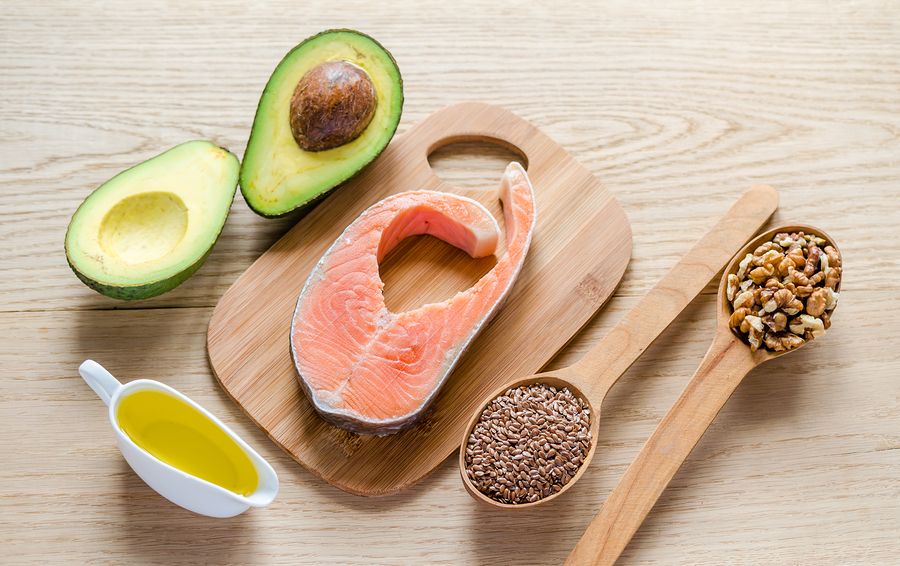Do you know your fats?
Polyunsaturated vs Saturated – which would you choose?
Lyndel Costain, registered dietician and member of Dieticians in Obesity Management (UK) advises; “it’s important to get the balance right. Some fat is essential to insulate and cushion the body, to help make vital hormones, to build cell membranes and provide essential fats that our bodies cannot make alone”.
Registered nutritionist Anita Bean also warns not to completely eliminate fat. “Research shows that if you’re trying to lose weight then including small amounts of fat in your diet can help. Choosing foods such as oily fish, avocados, nuts, olives and seeds, is a great idea as they can help burn body fat, improve aerobic capacity and even boost your immunity.”
“Oils such as flaxseed, olive and walnut along with nuts, seeds and oily fish are rich in essential fatty acids which helps to strengthen connective tissue around fat cells and is also good for the skin.”
A report from the Journal of Clinical Nutrition also tells us that even dressing vegetables with a little drizzle of oil will enhance the way antioxidant carotenoids are absorbed into the body, potentially making your body more resistant to disease.
Polyunsaturated and monounsaturated fats
Anita tells us we should all aim for the fats we eat to be monounsaturated or polyunsaturated with as little saturated fats in our diet as possible.
What are monounsaturated fats?
“Monounsaturated fat is good at lowering bad cholesterol levels”, says Anita. “It can also lower your risk of heart disease and cancer. It is found in oils such as olive, rapeseed and soya. It is also in sunflower and sesame seeds along with nuts such as cashews, almonds and peanuts.
What are polyunsaturated fats?
“There is the Omega 6 and the Omega 3 family of polyunsaturated fats”, explains Lyndel Costain. Both of these families of fatty acids are essential for cell membranes, growth and to produce the chemical messengers (eicosanoids) that help regulate blood pressure, blood clotting and immunity”.
Why Omega 3s is good for you
As Omega 3 is easily absorbed into cell membranes the benefits are far-reaching: along with keeping the brain, joints, heart and skin healthy research suggests it enhances mood too.
Omega 3 is present in oily fish such as mackerel, sardines, fresh tuna, trout, salmon, and herring. It is also found in pumpkin seeds, flaxseeds, flaxseed oil and soya oil.
It is believed that docosahexaenoic acid (DHA) in fish oils may help aid memory, concentration and even delay the onset of dementia. It works by strengthening brain cell membranes and boosting blood flow which in turn may improve brain function.
Research has also discovered that Omega 3 is a natural anti-inflammatory and can help with the symptoms of rheumatoid arthritis (as published in the medical journal: Drug Discovery Today). The destruction of cartilage may be slowed by taking fish oil supplements as well as alleviating inflamed joints.
Depression may also be alleviated by taking fish oil supplements. According to the American Journal of Psychiatry 6 out of 10 people suffering from depression claimed that fish oil supplements helped them better manage their symptoms.
Lyndel Costain tells us that some studies have established a slightly increased risk associated with eating very high amounts of oily fish. “Further research is needed but mercury levels found in the water are possibly to blame.”
Why Omega 6s is good for you
Omega 6 includes linoleic and gamma linoleic acid (GLA) which can be found in sunflower, soya, corn and safflower oils along with evening primrose oil and starflower (borage) oil. Taking evening primrose or starflower oil can help with PMS, menstrual breast pain and can also help with the symptoms of eczema.
According to Anita Bean, people have a tendency to consume more Omega 6 than Omega 3: “Foods rich in Omega 6 are easier to find than those rich in Omega 3. Eating more Omega 6 may lead to an imbalance in our bodies”.
Most diets have a ratio of 10:1 (Omega 6:Omega 3), but we should be aiming for no more than 5 times the amount of Omega 6 to Omega 3. Sunflower, sesame, pumpkin, hemp and linseed (flax) all contain naturally balanced combinations of the two fatty acids.
Eat less saturated fats
These are the fats that are hard at room temperature. They include butter, lard, block margarine and cooking fat. Along with dairy foods, saturated fats are also in meat, pastries, biscuits, cakes and deep-fried food.
Anita tells us “consuming too many saturates raises the level of cholesterol in the blood which may then be deposited in the arteries. This can lead to heart disease.”
Learn more about cholesterol here
Breast cancer is also a risk from having too much saturated fat in our diets. A recent study in the Journal of American College of Cardiology showed women who consumed more than 90g of fat a day were twice as likely to develop breast cancer than those who ate 40g or less a day.
The British Nutrition Foundation suggests that risk can be reduced by sticking to a saturated fat intake of no more than 10 to 20g a day.
Say no to trans–fatty acids
These are unsaturated fats that turn to trans-fatty acids when hydrogen gas is added to vegetable oil to make them more solid. Trans-fatty acids are in processed foods such as cakes, biscuits and other convenience foods.
Anita warns that trans-fatty acids can do more harm than saturated fats: “They raise the level of bad cholesterol in your body at the same time as reducing the level of good cholesterol (which is something saturated fat does not do).” Anita recommends we try and stay away from trans-fats.
Oxford University researchers call for food labels to be more transparent, showing trans-fats as well as cholesterol and saturated fat. Studies show that just a 2% increase in the consumption of trans-fatty acids results in a 23% increase in the incidence of coronary heart disease. It was also noted that the harmful effects of trans-fats were seen when only 20 to 60 calories were consumed in a day.
Did you know?
We have listed below the fat content of some common foods – some of these may surprise you!
• A 40g packet of crisps has approximately 13.5g of fat
• An average sized chocolate bar may contain 14g of fat
• One slice of Victoria sponge cake is approximately 12g of fat
• An average portion of takeaway chicken chow mein is 25g of fat
• 118g serving of a cheese and tomato thin based pizza has 9.5g of fat
Healthy fats
As our bodies need essential fatty acids to function properly here are some of what we should be eating:
• Butter – only 10g
• Avocado – a quarter to one half
• Low-fat mayonnaise – limit to 2 tablespoons
• Olive or rapeseed oil –one tablespoon
• Walnuts – only 4 to 6
• Sunflower or pumpkin seeds – 2 tablespoons
• Hummus – 3 to 4 tablespoons
• Oily fish such as sardines, mackerel, salmon, trout, herring – 150g
Read more here on
Disclaimer
All content on Silversurfers.com is provided for general information only, and should not be treated at all as a substitute for the medical advice of your own doctor or any other health care professional. Silversurfers will not be responsible or liable for any diagnosis made by a user based on the content on www.silversurfers.com and we are also not liable for the content of any external websites or links from or to Silversurfers to any other websites. Please always consult your own doctor if you’re in any way concerned about any aspect of your health
Melina - Assistant Editor
Latest posts by Melina - Assistant Editor (see all)
- Top tips for hay fever sufferers - April 14, 2024
- Paysan Breton Cream Cheese Breakfast Wraps - April 12, 2024
- 4 Homemade Sweet Treats for Easter - March 24, 2024
- Playground Memories - March 10, 2024
- The invasion of the duvet: the ’10-second bed’ - February 20, 2024





















